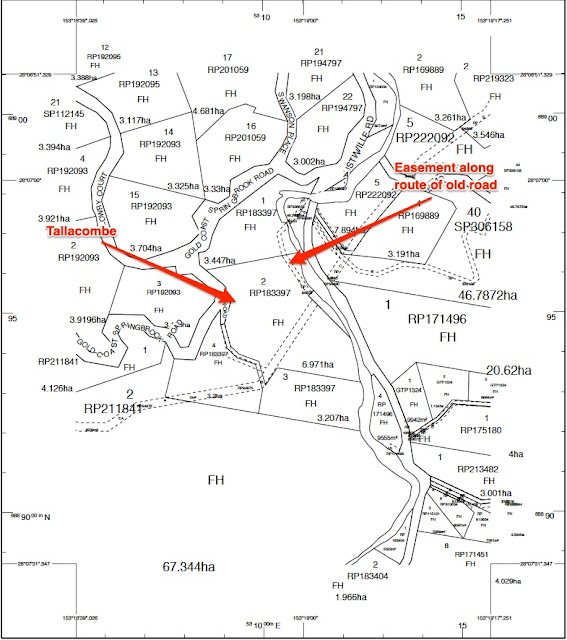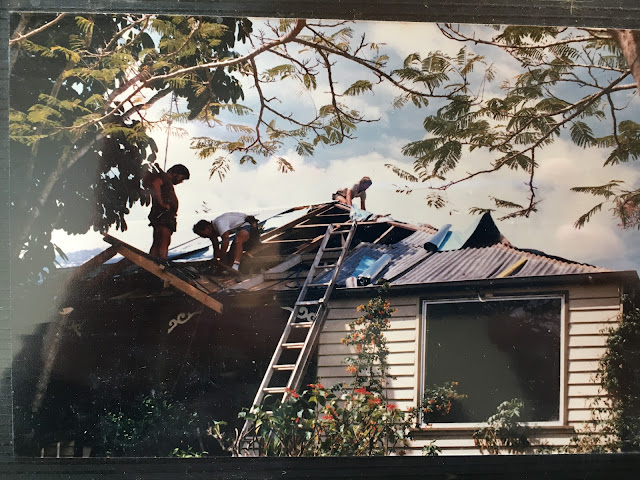Tallacombe is a house on the Springbrook Road at Neranwood, about 8 kilometres from Mudgeeraba. The name connotes a valley in the Tallai Hills. A sacred combe is discussed in the novel 'Daniel Martin' and describes a place to which one can retreat to nature for spiritual and creative renewal.
The Gold Coast Hinterland was settled in the late nineteenth century. The first land selections in the Mudgeeraba area occurred in 1869. Good overview here.
One of the principal early settlers was Isaac Andrews, who came from Londonderry to Australia in 1862. Isaac in due course came to own several blocks in the Mudgeeraba area, including some in the Neranwood area. See this map from 1910.
Notice how the road from Mudgeeraba is on the western side of the Mudgeeraba Creek, and there is at that time no Springbrook Road. This correlates with an easement on Tallacombe's deed.
Andrews and Schmidt went into partnership with a dairy, with the joint enterprise being eventually being taken over by the Andrews family.
It is not known exactly when the house currently called Tallacombe was built, but its layout corresponds to this advert, reproduced in a book 'The Australian House'.
We were told that the house had originally been situated on the other side of the valley, but that with the construction of the Springbrook Road, it had been cut in two and dragged by bullocks up to its present site, which catches the sun in the morning. There were signs of a dairy on the site.
The Mudgeeraba-Springbrook Road was opened in 1926. More history of the Springbrook Road here.
There were some significant failed enterprises in the area before the Second World War.
In November 1924, the Neranwood Tramway was opened. It ran from the Nerang Hardwood Company's sawmill which was sited on the lawn of Polly's Kitchen restaurant to the Mudgeeraba Railway Station. It only lasted a couple of years, closing in 1926.
Locomotive 'Alison' taking logs along the Neranwood Tramway to Mudgeeraba Station (approx 1925)
1930 map, after construction of Springbrook Road, showing route of tramway.
In 1934, after the Great Depression, the Austinville Settlement was established by Queensland Department of Labour and Industry, Mr W.H. Austin. A school was built, but the settlement only lasted for about five years.
In 1962, the Little Nerang Dam was completed, together with the water pipeline which crosses the property at Tallacombe.
Tallacombe in 1970.
The property apparently owned 'most of the valley' at one point, but by 1982 it had been reduced to 50 acres. It was then bought by Peter and Val Jones. Peter was a town-planner in the Albert Shire Council. He subdivided the property and put all five blocks up for sale.
We bought Lot 2 in January 1984, with the house on it, and 17 of the original 50 acres.
At the time, banks were obliged to control the interest rates on mortgages. As a result, they set a limit on what they could lend, and when I asked to borrow $80,000 to purchase the house, they told me they had 'run out of funds'. A bit like a pub with no beer! Then, after a delay, they told me I could borrow $100,000 as a 'personal loan', i.e. from funds that were not interest rate controlled. No, I couldn't only borrow $80,000. Weird.
So I said, OK, let me have $100,000.
Not so fast. The valuation ($117,000) of the property would not support a 75% collateral rate on $100,000.
Catch 22!
The upshot was that I had to agree to immediately increase the value of the property to more than $133,000, and the bank would advance me the money as the value increased. This meant, in effect, that we immediately had to knock over the car-port and build a two story extension.
Photo taken from the carport deck, now the middle of the new extension, upstairs.
The new two-story extension.
From the new part, looking towards the old part of the house.
The passage between the new and old parts of the house was modelled on this photo of the entrance to the tomb of the Egyptian pharaoh Rameses III, from Carl Jung's book 'Man and his symbols'.
Patching some dodgy weatherboards outside the main bedroom.
The front door in 1984.
The front porch restored and new steps
Bull-dozing the foaling paddock
Building the dining table
Renovating the old roof.
Building the deck near the swimming pool
Anna helping
Raising the roof in the bathroom
Tom building some cupboards
Laying out the shape of the swimming pool. 1988.
Digging a trench for grey water
Swimming pool goes in.
In 1990, the Austinville Valley was a site for consideration of a water storage dam. It would have led to all the houses in the valley being removed. This led to a campaign to 'Damn the Dam'.































